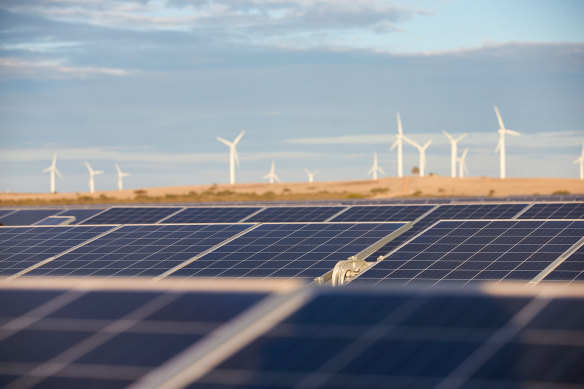Renewables cheaper than nuclear, coal now and into the future: CSIRO
Save articles for later
Add articles to your saved list and come back to them any time.
Electricity produced by renewables is cheaper than fossil fuels and nuclear power and is expected to remain the lowest cost power source for decades to come, according to findings from the top science agency which challenge the federal opposition’s campaign against the government’s climate policy.
The new findings were published in released in CSIRO’s GenCost report on Thursday, which includes projections that an electricity grid dominated by 90 per cent renewables would deliver considerably cheaper power to households compared to fossil fuel and nuclear alternatives.
Renewable energy will produce cheaper energy compared to coal and nuclear power, CSIRO says.
Opposition Leader Peter Dutton and his climate change and energy spokesman, Ted O’Brien, are calling for the government to halt the rollout of new energy transmission lines amid a farmer backlash over land access. The Coalition has mounted a campaign for nuclear power to be added to the nation’s energy mix.
Nuclear advocates have criticised previous CSIRO reports for not incorporating the costs of tens of billions of dollars of transmission lines needed to link the growing fleet of wind and solar farms across the country into population centres.
However, CSIRO has now included more than $30 billion of new transmission lines and projects to provide back up power when the wind isn’t blowing and the sun isn’t shining – such as the $12 billion Snowy 2.0 pumped hydro dam.
Its findings still showed that renewables were cheaper than nuclear, coal and other fossil fuels.
The report said that small modular reactors (SMR), a nascent technology not yet in commercial use but favoured by the opposition, would be far more expensive than coal and gas plants as well as renewables.
How did CSIRO calculate the costs?
GenCost uses the metric known as the levelised cost of electricity. This is how much it costs for a power plant to generate electricity, which includes capital expenditure as well as the revenue required to create a return on investment.
The report showed that a mix of wind and solar power in 2023 would generate electricity for $90 to $134 per megawatt hour.
This cost range is projected to fall to a $70 to $100 by 2030 – with renewables generating 90 per cent of the grid’s electricity. The Albanese government has set a target for renewables to reach 82 per cent of the energy mix by 2030.
CSIRO found coal generation is more expensive, even without the cost of transmission lines to link the power stations to the grid. Coal electricity generation costs between $110 and $220 per megawatt hour in 2023. This price drops slightly to a range of $85 to $135 in 2030.
The nuclear option
Dutton is calling for Australia to join a global “nuclear renaissance”, which would require removing the 1998 ban on nuclear energy and building small modular reactors on the site of retired coal-fired power plants.
US company NuScale was developing the world’s most advanced commercial SMR project in Utah, but the project was abandoned in November due to a 70 per cent blowout in project costs.
Using the NuScale project as a guide, CSIRO found that were SMR technology available today it would generate electricity at a cost of $380 to $640 a megawatt hour. This marked an increase from its July projections for SMRs to generate electricity at between $200 and $350 per megawatt hour.
CSIRO said SMR costs would fall as the technology develops, with a projected cost of $210 to $350 a megawatt hour of electricity generation in 2030.
NuScale’s development in Utah was expected to take at least 15 years to switch on, and CSIRO said this was a reasonable time frame to assume for Australia – if the current legislative ban on nuclear energy was removed and the necessary political support was in place.
Start the day with a summary of the day’s most important and interesting stories, analysis and insights. Sign up for our Morning Edition newsletter.
Most Viewed in Politics
From our partners
Source: Read Full Article
